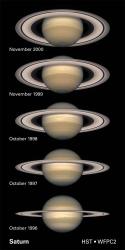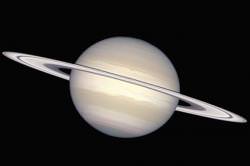Are you ready to take a closer look at the real “Lord of the Rings”? Then say hello to Saturn as it reaches opposition tomorrow night. With the yellow planet rising around sunset, highest in the south around midnight, and setting around sunrise, now is the time for observers and photographers to enjoy Saturn the most!
Right now Saturn is positioned in Leo about 5 degrees east of the constellation’s Alpha star – Regulus. Look for the asterism of a backwards question mark rising after sunset and the brightest “star” in the group will be Saturn! For observers who use only your eyes try comparing the distances by holding your hand at arm’s length. Saturn and Regulus will be separated by about 3 fingerwidths. Look less than a fistwidth further north and you’ll see a dimmer star – Gamma Leonis. Keep an eye on this trio in the days to come and you’ll easily see Saturn’s movement against the background stars!
For observers with binoculars, it’s possible to see elongations on either side of Saturn which are the beginnings of its ring system trying to resolve. Before you complain about not getting a good enough view, remember what you’re seeing is very much like what Galileo saw when he discovered Saturn in 1610. Saturn on Saturday? Why not! Saturn was named for the Roman god of agriculture and the day Saturday is also named after him.
While you’re watching, think on this… Saturn is the second biggest planet, but it’s also the lightest planet. If there was a bathtub big enough to hold Saturn, it would float in the water! Its diameter is approximately 75,000 miles (120,000 km) and more than 9 Earths could line up across it. It’s composed of 97% hydrogen gas, about 3% helium gas and about 0.05% methane, plus ammonia. One of the reasons it appears slightly flattened is because it is! Saturn rotates in 10 hours, 39 minutes in Earth time and this fast pace is what gives it a unique shape. It takes Saturn almost 30 years to complete an orbit around the Sun!
Now on to observing with a small telescope…
 What’s that you say? You can barely see Saturn’s rings? You’re right. At the moment Saturn’s rings are only tilted about 8 degrees from our line of sight. Earth’s equator is tilted 23 degrees and this tilt gives our planet its four seasons. Each year as we orbit around the Sun, our tilt causes different parts of the planet to spend more time in sunlight. Days become longer… nights become shorter! Saturn’s equator is tilted very similar to ours at 27 degrees. This gives Saturn the same seasonal changes as we here on Earth experience. Because of the tilt of Saturn and the thinness of the rings, every 14 years the rings look like they’ve disappeared when viewed through a small or medium sized telescope.
What’s that you say? You can barely see Saturn’s rings? You’re right. At the moment Saturn’s rings are only tilted about 8 degrees from our line of sight. Earth’s equator is tilted 23 degrees and this tilt gives our planet its four seasons. Each year as we orbit around the Sun, our tilt causes different parts of the planet to spend more time in sunlight. Days become longer… nights become shorter! Saturn’s equator is tilted very similar to ours at 27 degrees. This gives Saturn the same seasonal changes as we here on Earth experience. Because of the tilt of Saturn and the thinness of the rings, every 14 years the rings look like they’ve disappeared when viewed through a small or medium sized telescope.
For larger telescopes, it’s easier to see Saturn has a thin multiple ring system. The rings are made of chunks of rock and ice — some just tiny pieces of dust, some more than half a mile (one km) across. Observing Saturn at opposition is important because it will give you an opportunity to witness the Seeliger Effect. Only at opposition will you notice a distinct brightening of the ring system caused by backscattering of sunlight off the icy particles. While we’re “lined up”, keep an eye out for this unusual property as well as the shadow of the rings on the planet and the shadow of the planet on the rings.
And don’t forget those moons… Titan is easy visible to even small telescopes!


Come on Tammy… “real Lord of the Rings”….
Ugh….
Yes yes! In fact, the day of the lunar eclipse I was in total awe as I was able to see Saturn as a DISK, and not as a point, and not only that, but as an OVAL disk! And not only that, but as a YELLOW oval disk!
And only with a 10×50 binocs!!! Wich I’ve owned for about maybe two months now. A terrific buy.
Check out this pic I took, with the moon, Saturn and two leo stars, I will upload more soon… hopefully…
Saturn’s already named after a deity, isn’t that wicked cool enough?
LOL! How about Ring King? 😉
Good job, Haplo! I’m glad to hear you like the binoculars and I’ll try to get some observing articles out for binoculars soon.
Great pic!
Look up the word “saturnine”… I just love all the astronomical implications!
During the Lunar Eclipse in the bitter Chicago winter, we had telescopes targeting the Moon of course, but had one trained on Saturn. Both objects made for a great experience for the 700+ visitors who were awed by the copper Moon and rings.
I think I’ll have “Saturn” parties this spring and summer and say good by to the rings for awhile.
Thanks Tammy for the opposition reminder.
Chicago Astronomer Joe
Administrator
Telescope/Observatory Operator
Adler Planetarium
Although Saturn has the lowest density, it is not the lightest. It is the only planet that would float if we could find a big enough tub.
All 4 of the terrestrial planets are lighter as are Uranus & Neptune, and the once planet Pluto.
it’s important to distinguish between mass and density.
Thanks, I’ll have my scope out tonight!
well its 10pm est 2 23 08 and saturn is beautiful from michigan. i wonder if those 2 nearby dots are moons? 1 perhaps titan?
Observed Saturn last nite man it was awesome,through my 16 inch dob,can’t wait for next weekend when the full moon will be gone.
Very nice article Tammy,its going to be a great Saturn season
I would almost guarantee you’ve seen Titan! Titan is suprisingly bright and orbits well outside (visually) from Saturn. Try observing over several nights and you can’t miss its movement!
For those of you who enjoy trying to identify Saturn’s moons, use this great tool:
http://www.wwu.edu/depts/skywise/saturn.html
From an observational standpoint, it’s easy to see the smaller, inner moons if you understand what to look for. In a small telescope, they are always right along the ring plane. Be patient, wait for a moment of clarity, and you’ll spot the little troopers for a brief moment! Once you understand what they look like and where to see them, you’ll be able to distinguish them far easier the next time.
Keep up the good work with sharing the view! There is no more awesome feeling in the world than to watch someone’s eyes (even in the dark) as they see Saturn for the first time!
Real Lord of the Rings works for me. Saturn is the King. Thanks for a great website and I really have learned alot listening to your podcasts. LOL. Thanks!